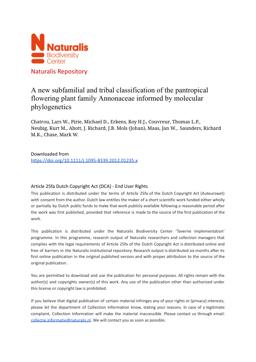2012-04-18
A new subfamilial and tribal classification of the pantropical flowering plant family Annonaceae informed by molecular phylogenetics
Publication
Publication
Botanical Journal of the Linnean Society , Volume 169 - Issue 1 p. 5- 40
The pantropical flowering plant family Annonaceae is the most species-rich family of Magnoliales. Despite long-standing interest in the systematics of Annonaceae, no authoritative classification has yet been published in the light of recent molecular phylogenetic analyses. Here, using the largest, most representative, molecular dataset compiled on Annonaceae to date, we present, for the first time, a robust family-wide phylogenetic tree and subsequent classification. We used a supermatrix of up to eight plastid markers sequenced from 193 ingroup and seven outgroup species. Some of the relationships at lower taxonomic levels are poorly resolved, but deeper nodes generally receive high support. Annonaceae comprises four major clades, which are here given the taxonomic rank of subfamily. The description of Annonoideae is amended, and three new subfamilies are described: Anaxagoreoideae, Ambavioideae and Malmeoideae. In Annonoideae, seven tribes are recognized, one of which, Duguetieae, is described as new. In Malmeoideae, seven tribes are recognized, six of which are newly described: Dendrokingstonieae, Fenerivieae, Maasieae, Malmeeae, Monocarpieae and Piptostigmateae. This new subfamilial and tribal classification is discussed against the background of previous classifications and characters to recognize subfamilies are reviewed.
| Additional Metadata | |
|---|---|
| , , , | |
| doi.org/10.1111/j.1095-8339.2012.01235.x | |
| Botanical Journal of the Linnean Society | |
| Organisation | Staff publications |
|
Chatrou, Lars W., Pirie, Michael D., Erkens, Roy H.J., Couvreur, Thomas L.P., Neubig, Kurt M., Abott, J. Richard, … Chase, Mark W. (2012). A new subfamilial and tribal classification of the pantropical flowering plant family Annonaceae informed by molecular phylogenetics. Botanical Journal of the Linnean Society, 169(1), 5–40. doi:10.1111/j.1095-8339.2012.01235.x |
|
